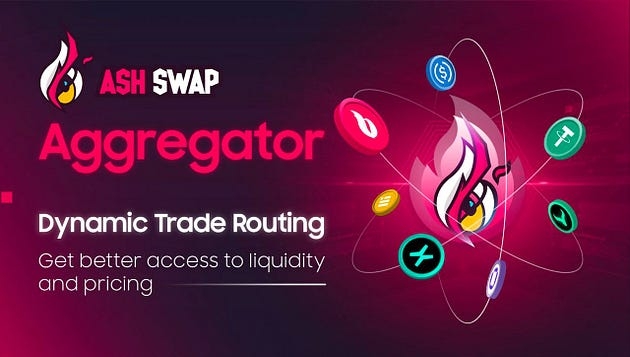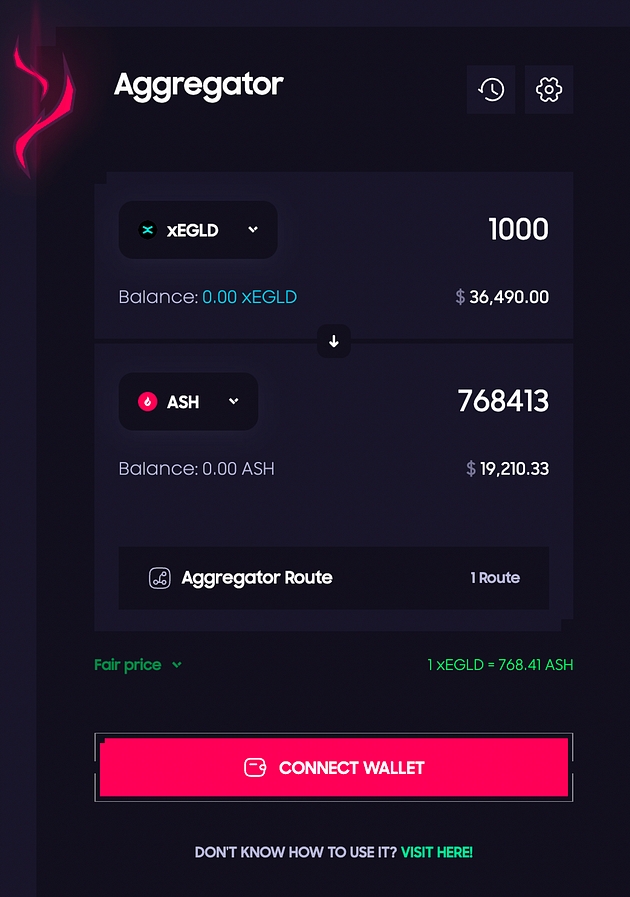🔀Understand Aggregator
The first Dynamic Trading Route Aggregator on MultiversX
AshSwap began as a stable-swap AMM DEX and has since grown to become one of the top two most dominating DEXes on MultiversX, with over $5 million in TVL (Total Value Locked). Our ultimate goal is to become a DeFi layer on MultiversX, where we will provide all advanced features to help DeFi users maximize profits and improve liquidity.
As part of our ongoing efforts to build new products on AshSwap, we are excited to announce AshSwap Aggregator, the first Dynamic Route Trading DEX Aggregator on MultiversX.
Let’s look at how AshSwap Aggregator gives you better access to liquidity and price.

Demand for DEX aggregation on MultiversX
MultiversX, a young blockchain network supporting more and more decentralized financial operations, permits users to exchange tokens and other digital assets. The need for DEX aggregators on the MultiversX blockchain will grow exponentially along with the MultiversX DEX trading volume, including AshSwap. Therefore, an efficient DEX aggregator will bring great benefits to the prospering MutliversX ecosystem.
AshSwap DEX Aggregator aims to serve as the go-to trading portal on MultiversX by ensuring a seamless, efficient, and secure trading experience. Thanks to our Dynamic Trade Routing, Each user will receive a full package of information on prices, slippage, and gas fees via the most optimal route.
What is a DEX Aggregator?
The only challenge that DEXs face is the lack of liquidity for smaller tokens and pricing. To solve this particular issue, DEX Aggregators are created. These aggregators are also called Liquidity Aggregators.
In simple terms, DEX aggregators are the financial protocols that give traders/investors easy access to various trading pools using a single dashboard. They rely on a complicated algorithm that considers multiple factors before selecting the best possible route for a specific token swap across the available platforms.
In the world of decentralized finance (DeFi), we have two eras of aggregator systems:
Static Trade Routing
Aggregators help users find the best paths for swapping tokens. Users can choose the desired path, and the system usually presents them with sorted results, highlighting the most favorable options.
DEXes such as Uniswap V2 and PancakeSwap also use this routing model. In the MultiversX ecosystem, you must be familiar with this type of routing in JEXchange.
Dynamic Trade Routing
This is an improvement over Static Trade Routing. After finding all possible paths, the aggregator system distributes the input token amount across different paths to achieve the best possible price. Unlike Static Trade Routing, which relies on a single path, Dynamic Trade Routing provides better outcomes by leveraging multiple paths.
This type of routing has been implemented on many leading multi-chain DEX aggregators, such as 1inch, ParaSwap, and KyberSwap.
AshSwap is the early adopter to bring it to MultiversX.

AshSwap Aggregator: A gateway to better liquidity and pricing
Dynamic Trade Routing Scheme
In a DEX, when attempting to swap a large amount of Token A for Token B using a single path, the price of Token B increases proportionally due to the depletion of liquidity along that path. Dynamic Trade Routing addresses this issue by dividing the large token amount into smaller portions and executing swaps across multiple paths. As a result, the price of Token B increases less compared to the previous approach.
AshSwap Aggregator has Dynamic Trade Routing, aggregating fractured liquidity across DEXs, enabling users to source the most capital-efficient liquidity to support their trades. Your trade on AshSwap is split into smaller trade sizes.
For example, if you want to make a 1000 wEGLD-BUSD trade, it may distribute your trade into a 950 wEGLD-BUSD trade on AMM1, 30 wEGLD-BUSD trade on AMM2, and the rest on the third route.
The percent distribution of the swap is dynamically determined to give you the best price. Trade splitting helps get better prices for large trades and trades with tokens where shallow liquidity is spread out across several DEXes. You can see exactly which DEXs were involved in the trade and the amount split between them.

Other key benefits of AshSwap Aggregator
Market listing
At the moment, AshSwap Aggregator is supporting two DEXs: AshSwap and xExchange, and tokens that are available in AshSwap pools (xEGLD, wEGLD, ASH, USDT, BUSD, USDC, UTK, HTM, sEGLD, HsEGLD)
However, the system is designed to be modular and extensible, allowing for the inclusion of more new DEXes and strategies to continuously improve the search for the best price; thus, we will support more tokens and markets in the future.
Swap in a single transaction
We have worked to optimize the AshSwap Aggregator so that it all fits within the transaction limits and that swapping can be done in one transaction. This is important to handle cases where the price of the token you are buying has changed and no longer fits your slippage limit. If the aggregator cannot make the trade with your slippage limit, it will roll back the transaction and return an error.
Friendly UI
We aim to make the UI as intuitive and user-friendly as possible. The user interface of the AshSwap Aggregator remains the same as the Swap's but with a twist. We have added a window showing detailed aggregator routing. Now, users can see the entire amount split and the exchanges involved in the routing.

Notice: The screenshots used in this post are for demonstration purposes only. Values are not accurately presented.
To sum up
AshSwap is delivering a sustainable liquidity infrastructure for DeFi on MultiversX. As a liquidity hub, AshSwap Aggregator connects liquidity from various protocols and sources to provide the best token rates to traders with minimal slippage.
For Aggregator Integration
Please kindly check our SDKs page for further information
Last updated
Was this helpful?